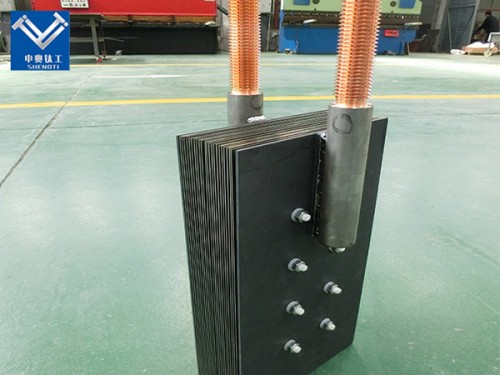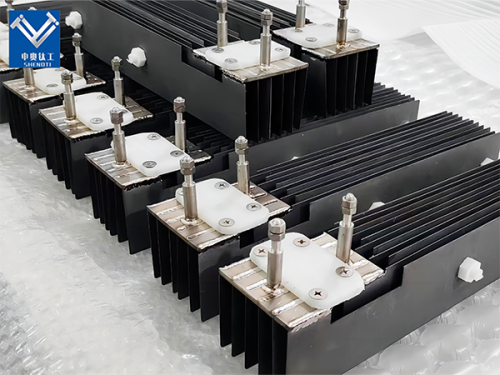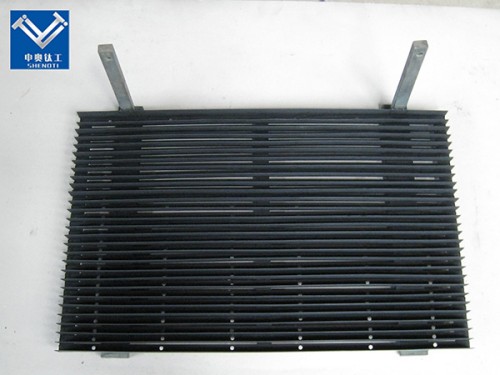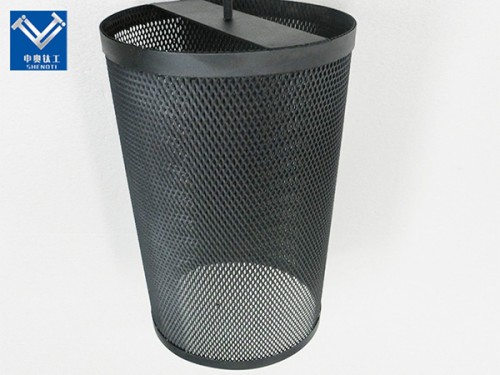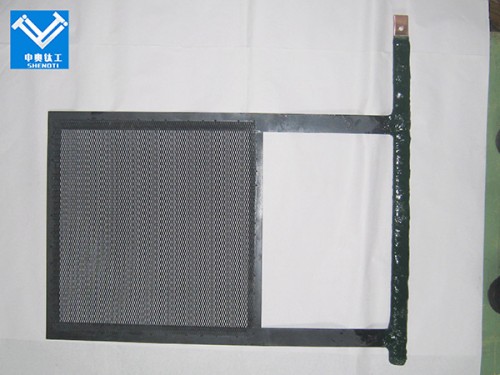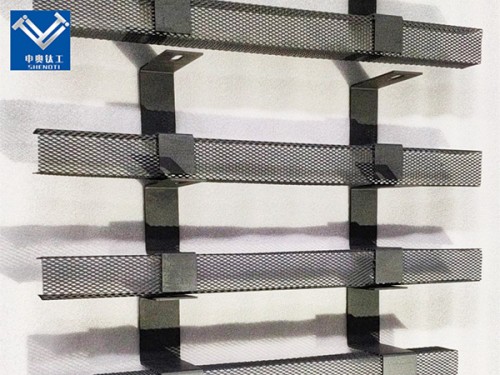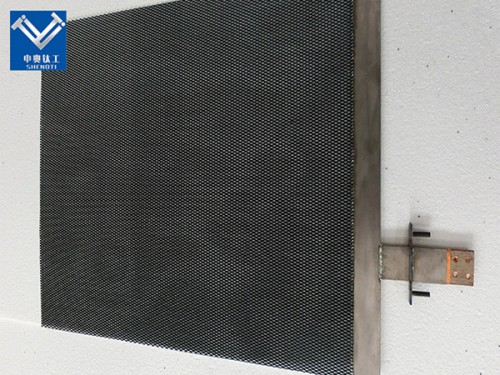
Why are DSA titanium anodes ideal for chlorine and wastewater treatment?
2025-06-10 15:59:18
Why are DSA titanium anodes ideal for chlorine and wastewater treatment?
Electrochemical disinfection—using chlorine generated in situ—is a cornerstone of modern water and wastewater treatment. At its heart lies the electrocatalytic anode: the surface where chloride ions are oxidized to chlorine gas (or hypochlorous acid/hypochlorite in water). Among the many electrode materials, Dimensionally Stable Anodes (DSA) made of titanium coated with mixed metal oxides (MMO)—notably those rich in ruthenium oxide—have set the industry benchmark.
1. Exceptional corrosion resistance and durability
Titanium provides a rugged substrate: it's lightweight, resistant to corrosion, mechanically robust, and dimensionally stable. On top, layers of oxides—such as ruthenium dioxide (RuO₂), titanium dioxide (TiO₂), and sometimes iridium dioxide (IrO₂)—form a protective and catalytic skin. This meld prevents dissolution or pitting that plagued older anodes like graphite or lead dioxide.
Over thousands of hours under high current density, MMO DSAs may lose just a few micrometers of coating—an unheard-of lifespan compared to legacy materials. Their longevity translates into dramatically lower downtime, maintenance, and replacement cost.
2. Efficient electrocatalysis with low overpotential
Electrochemical chlorine evolution requires oxidizing chloride at high potentials. MMO-coated titanium offers a low overpotential for the chlorine evolution reaction (CER). Low overpotential means:
Lower energy consumption (kWh per kg of Cl₂ produced),
Reduced formation of unwanted side-reaction products (e.g. oxygen evolution),
and more targeted chlorine production.
Ruthenium oxide, in particular, is one of the most active catalysts for CER—contributing significantly to the high efficiency of these anodes.
3. Self‑passivating oxide matrix
The MMO layer (70–95% RuO₂ with TiO₂ binder typically) forms a porous, self-healing network. If microscopic cracks or wear occur, the oxide matrix redeposits during operation—maintaining the catalytic surface and preventing bare titanium exposure. This ensures stable performance over long-term operation in harsh, chlorinated environments.
4. Operational flexibility and low maintenance
DSA electrodes can operate over a wide pH range (acidic to alkaline), tolerate suspended solids, organics, and heavy metals, and function in continuous or intermittent modes without degradation. They require no precious-metal load monitoring or specialized cleaning—drastically reducing O&M resources.
5. Environmental & safety advantages
On-site electrochlorination via MMO titanium anodes eliminates the need to ship and handle industrial chlorine gas or bleach—enhancing both safety and environmental footprint. The electrogeneration process produces only hypochlorite/chlorine on demand, and helium-baked oxide coatings provide negligible leaching, reducing metal pollutants in treated water.
These factors combine to make DSA titanium anodes—especially ruthenium‑coated ones—ideal for cost-effective, energy-smart, and sustainable chlorine production in water treatment.
How does ruthenium coating enhance titanium anode performance in wastewater disinfection?
What does ruthenium oxide bring that other oxides don’t?
Ruthenium oxide (RuO₂) stands out for its:
Low electrical resistance, enabling smooth electron transport,
Superior catalytic activity for the chlorine evolution reaction,
Excellent chemical stability in strong oxidative environments.
While cheaper oxides (TiO₂, SnO₂, IrO₂) impart durability, they lag in activity. RuO₂-rich coatings balance activity and lifespan—typically 70–90% RuO₂ by weight, topped with protective binders.
Chlorine production efficiency is proportional to the RuO₂ content. However, pure RuO₂ coatings wear faster. A 70/30 TiO₂ mixture, or a small addition of IrO₂, achieves performance - high efficiency with lower coating loss. The formulation and deposition method (e.g. thermal spray, dip coating) are optimized to maximize porosity, reduce defects and promote long-term self-healing.
Real‑world results
Energy efficiency: RuO₂-based DSAs typically use 10–20% less energy per kg of chlorine than PbO₂ or graphite anodes.
Operational lifespan: Field data report stable performance over ≥20,000 hours. Precious-metal loadings stay >95%, and overpotential increases <50 mV in 5–10 years.
Quality of disinfection: RuO₂ promotes selective chlorine formation with fewer side products (O₂, perchlorates), improving disinfection while minimizing by‑products.
Ruthenium in emerging contaminants removal
Beyond routine disinfection, ruthenium‑coated anodes show effectiveness in degrading pharmaceuticals, cyanotoxins, and PFAS precursors—using reactive chlorine species and hydroxyl radicals generated electrochemically. The high reactivity and selective oxidation pathways make RuO₂ surfaces adept at breaking down complex contaminants in wastewater.
Case examples
Electrocoagulation pretreatment: MMO anodes generate coagulant in situ without chemical addition—enhancing suspended solids removal while protecting membranes downstream.
High‑salt wastewater: Even with ≥10 g/L NaCl, Ru‑DSAs maintain >90% current efficiency and >5 kA/m² current density—demonstrating resilience.
Surface water reuse projects: RuO₂-based electrochlorination systems are used to disinfect wastewater for reuse in cooling towers and irrigation—balancing cost, performance, and footprint.
What are the cost and lifetime trade‑offs of Ru‑coated titanium DSA vs. alternative anodes?
Up‑front vs. life‑cycle economics
|
Anode Type |
Initial CapEx |
Lifetime/Replacement |
Energy Efficiency |
O&M Effort |
|
PbO₂ Graphite/Lignin based |
Low |
Low (months) |
Poor |
High |
|
Boron doped Diamond (BDD) |
Very high |
Very long |
Excellent |
Moderate |
|
MMO Ti DSA (70–90% RuO₂) |
Moderate |
Very long |
High |
Low |
|
Mixed MMO w/o Ru (e.g. IrO₂ TiO₂) |
Lower |
Long |
Moderate |
Moderate |
Capital costs: RuO₂-coated titanium DSAs cost more than non-Ru coatings but far less than exotic materials like BDD.
Operating costs: Much lower energy and replacement frequency reduce long-term expense.
Total cost of ownership (TCO): Over a 10‑year life, Ru‑DSAs are often 20–40% cheaper per kg Cl₂ output than alternatives—even counting higher material cost.
Reliability reduces hidden cost
Downtime from anode failure often dwarfs replacement cost. MMO DSAs continue serving 5–10+ years at industrial scale, providing operational stability and predictable budgeting that cheaper anodes cannot guarantee.
Contact Us
For more information on Ruthenium Coated Titanium Electrodes (DSA) or to discuss application in your facility, please reach out:
Baoji City Shenao Metal Materials Co., Ltd. Email: zh@baojiti.com.cn
Our technical team is ready to help with sizing, part selection, pilot testing, or full-scale deployment.
YOU MAY LIKE











